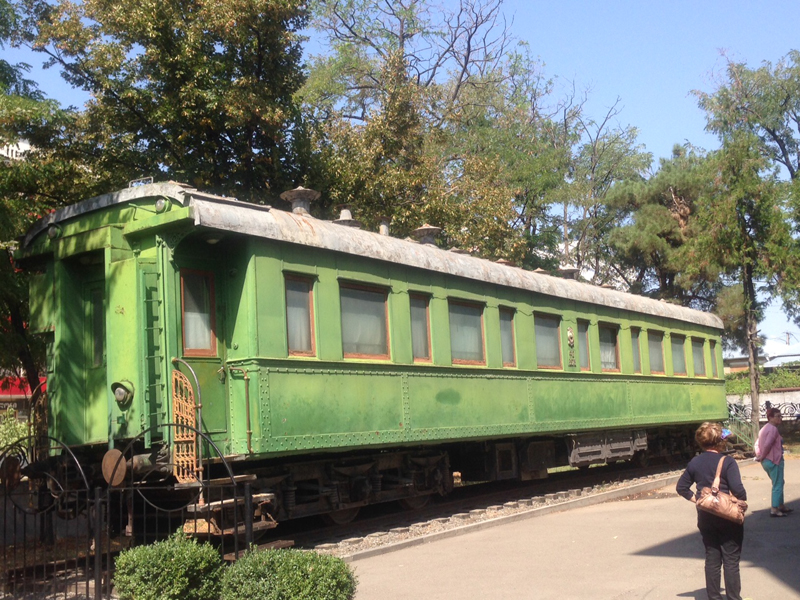Georgia on my mind
This item appears on page 27 of the March 2016 issue.
Many travel agents, in planning trips to Eurasia, lump three countries into a single unit. Nestled together in a corner against the Caspian Sea, those countries are Azerbaijan, Georgia and Armenia. My wife, Margo, and I visited them in July-August 2014.
Although Azerbaijan is officially Muslim and Georgia and Armenia are both Christian, you can stroll down the streets in any of these countries and not realize which one you’re visiting. All three are thoroughly Westernized; women wear cutoffs and short shorts and don’t draw a second stare.
The alphabets and languages of each country are similar but not identical. Many store signs are set in both the local Cyrillic-type language and Roman spelling.
Smoking is as universal as it was in the US before the surgeon general’s report.
But one element isn’t quite so universal. Although in all three the highways are, to use a euphemism, a mess, I nominate Georgia for having the worst. It’s a “bounce and jounce” adventure from pothole to pothole, and drivers have chutzpah beyond what you’d ever experience in the nastiest traffic jam in Cairo or New York City.
Georgia, in particular, is loaded with hidden sightseeing gems. From the US, you would typically fly into London’s Heathrow Airport and board a British Air flight nonstop to Baku, Azerbaijan’s capital. It is, by far, the biggest city in the Caucasus. From there, you would travel by car, switching vehicles and guides at each border.
Margo made our travel arrangements online. In each country, we had a car and driver. (Sometimes the car had a right-hand drive.) We never considered attacking the multiple regulations against taking a car across one of the controversial borders.
Once we left Baku, the “Four Seasons” type of hotel passed into history. However, whether it was an actual hotel or a bed-and-breakfast, lodgings were universally clean, if somewhat spartan.
Breakfast was usually included with the room. Wherever we went, we saw the same foods being served: Greek-style yogurt, hard-boiled eggs, mushy bread, cheese, cereal similar to cornflakes, unidentifiable fruit juice and fruit. The fruit varies, depending on the season, but on our trip it was often some sort of melon. We usually made our own instant coffee.
Measuring just under 27,000 square miles, Georgia is a small country. It has a population of 4.6 million, almost half of whom live in and around Tbilisi, the capital.
As our car jounced from one fort or monastery to another, we began to wonder whether Georgia had set a world record for per-capita forts and monasteries.
One of the best-known monasteries we saw was Vardzia. Inspired by Queen Tamara, the fort/monastery was literally whacked out of Mount Erusheli in the 12th century. At 13 stories tall, it seemed to rise forever.
Then there were the 12th-century Gelati Monastery, the 11th-century Motsameta Monastery and the 13th-century Metekhi Church. It seemed that every wooded hill had its own historic fort. Though we sometimes tired of the historic sameness, the power of the magnificent wooded settings made just being there worthwhile.
Georgia’s most famous citizen, Joseph Stalin, was born in the village of Gori in 1879, but many Georgians consider Tbilisi, where he began his political career, as his place of origin. In Gori’s town center is the Joseph Stalin Museum. A life-sized stone statue of Stalin and the railway car in which he traveled are nearby.
Since Stalin’s death in 1953, long before the breakup of the USSR, he seems to have become a father figure in Georgia. Whatever one’s opinion of the brutal politician, the museum’s Stalin memorabilia is worth more than a passing look.
In Georgia, we found American credit cards almost useless; the employees in most places just stared at them. Instead, you’ll need to pay in cash in the local currency. Except within the two big banking centers — Baku in Azerbaijan and Tblisi in Georgia — there was no interchangeability of currencies between countries.
The value of the Azerbaijan currency, the manat, ended at the border, so at a bank or exchange as you’re nearing the Georgian border, swap your currency for dollars or euros. After crossing into Georgia, you can swap your dollars or euros for lari, the local currency. The exchange rate wasn’t damaging.
Twice, when we had a Georgian hotel handle our laundry, we were “had.” Having clothes washed plus a few shirts ironed, we were nailed for $60 in one hotel and about $70 in another. Arguments went nowhere. In Armenia, a bigger bundle cost us only about $15.
American tourists are rare in Georgia. That certainly is understandable, weighing distance against cost.
Ahh, but wherever one travels on this planet, finding mile after mile of unspoiled natural beauty is hard to match.
HERSCHELL GORDON LEWIS
Pompano Beach, FL

